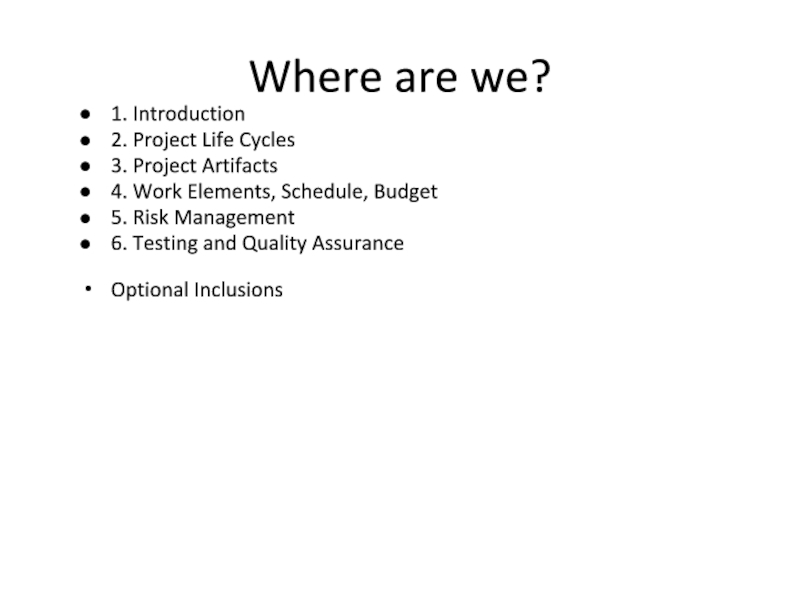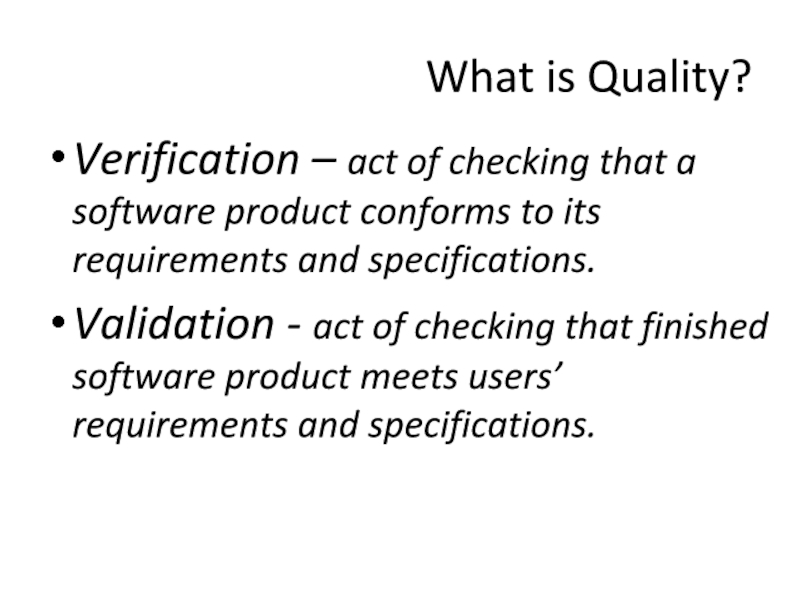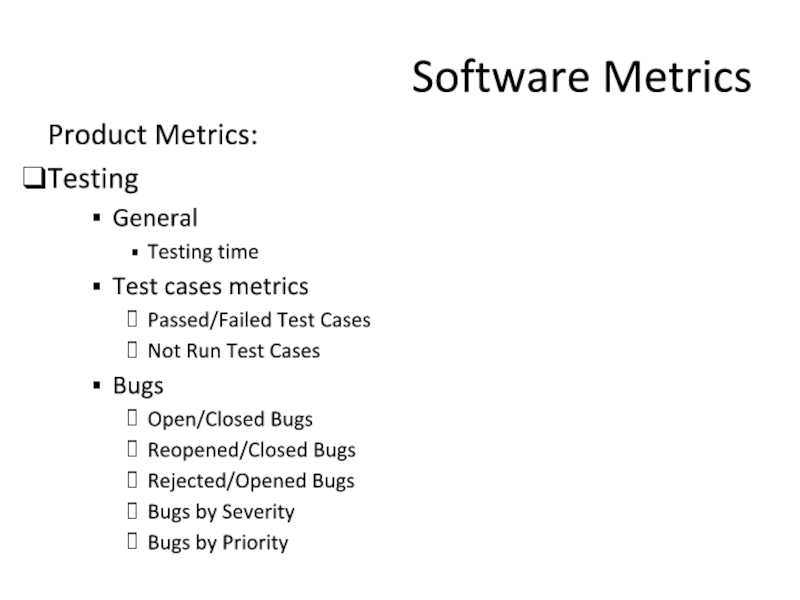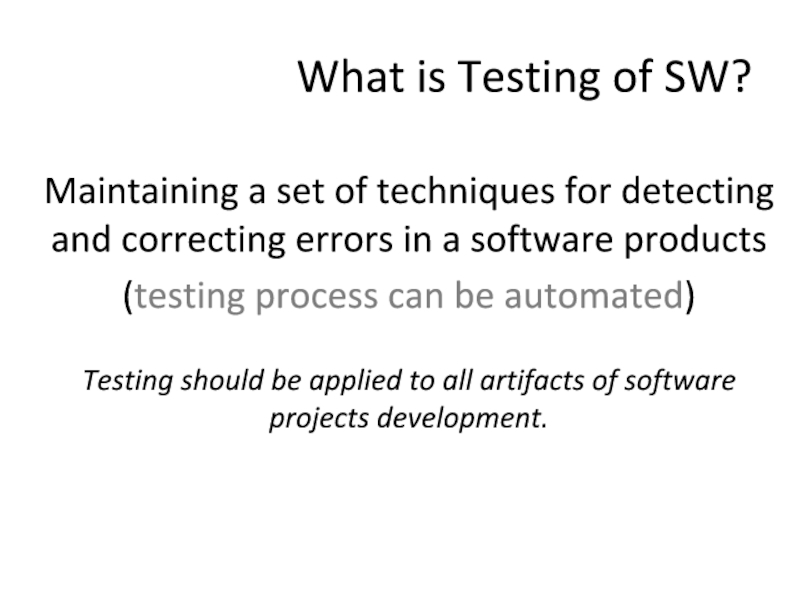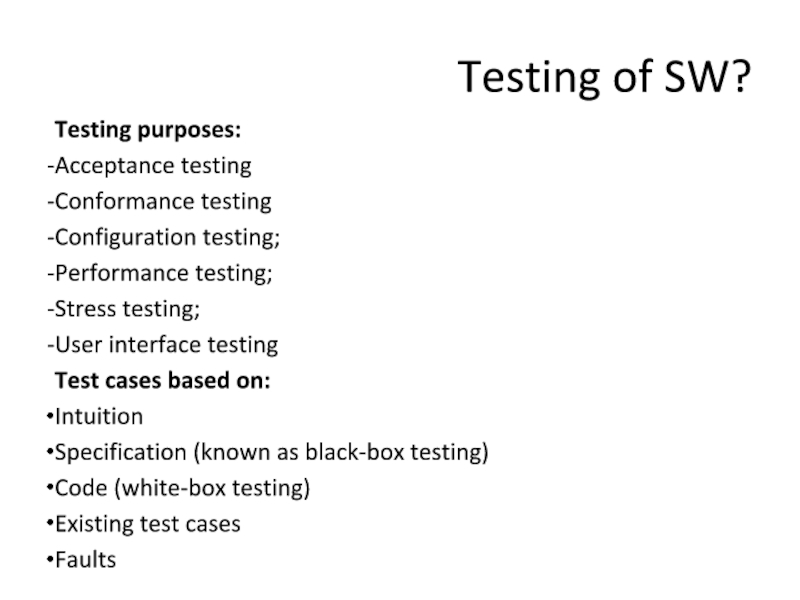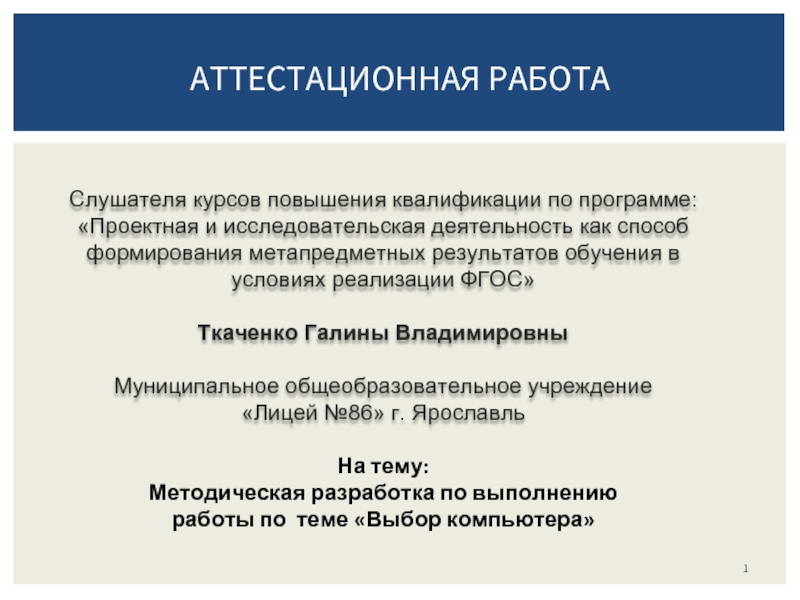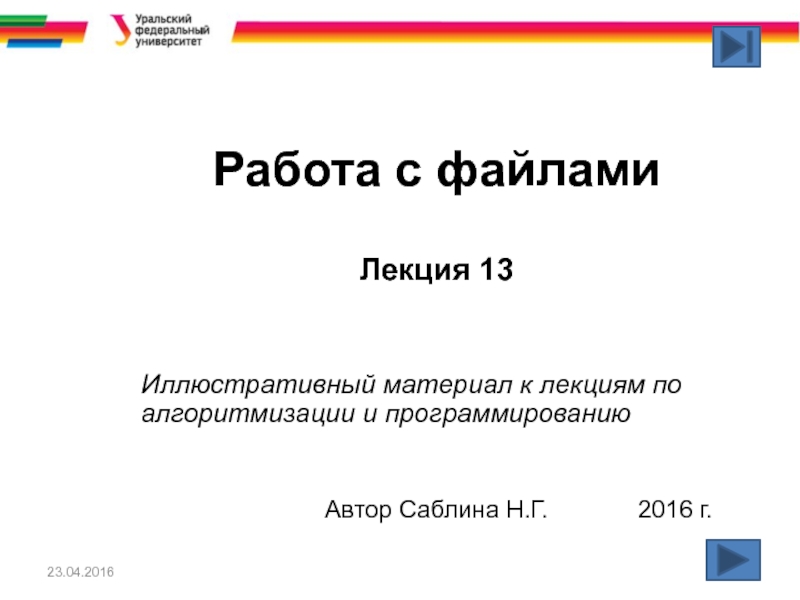- Главная
- Разное
- Дизайн
- Бизнес и предпринимательство
- Аналитика
- Образование
- Развлечения
- Красота и здоровье
- Финансы
- Государство
- Путешествия
- Спорт
- Недвижимость
- Армия
- Графика
- Культурология
- Еда и кулинария
- Лингвистика
- Английский язык
- Астрономия
- Алгебра
- Биология
- География
- Детские презентации
- Информатика
- История
- Литература
- Маркетинг
- Математика
- Медицина
- Менеджмент
- Музыка
- МХК
- Немецкий язык
- ОБЖ
- Обществознание
- Окружающий мир
- Педагогика
- Русский язык
- Технология
- Физика
- Философия
- Химия
- Шаблоны, картинки для презентаций
- Экология
- Экономика
- Юриспруденция
Quality assurance and testing презентация
Содержание
- 1. Quality assurance and testing
- 2. Where are we? 1. Introduction 2.
- 3. Outline Software Quality Assurance Plan Definition of
- 4. Outcomes Understand the key parts of the
- 5. Software Quality Assurance Plan The purpose of
- 6. Software Quality Assurance Plan Set common templates
- 7. What is Quality? How do you understand
- 8. What is Quality? Verification – act of
- 9. Fault, failure and error Fault/defect – a
- 10. Software Project Metrics Tools for anyone involved
- 11. Software Metrics Reduce cost by 15% -
- 12. Software Project Metrics Life Cycle Step metrics
- 13. Software Project Metrics Project metrics: Completed activities
- 14. Software Metrics Requirements Metrics: Frequency of change
- 15. Software Metrics Process Metrics:
- 16. Software Metrics Product Metrics: Testing General Testing
- 17. What is Testing of SW? Maintaining a
- 18. Testing Test Plan - a document describing
- 19. Testing Master Test Plan: A single high-level test
- 20. Testing of SW? Who does the testing
- 22. Testing of SW? Testing purposes: Acceptance testing
- 23. Product Complexity Metrics Source lines of code.
Слайд 2
Where are we?
1. Introduction
2. Project Life Cycles
3. Project Artifacts
4. Work Elements,
Schedule, Budget
5. Risk Management
6. Testing and Quality Assurance
Optional Inclusions
5. Risk Management
6. Testing and Quality Assurance
Optional Inclusions
Слайд 3Outline
Software Quality Assurance Plan
Definition of quality for software products
Software Metrics
Software Testing,
types of testing
Слайд 4Outcomes
Understand the key parts of the Software Testing process
Know how to
identify the metrics of software
Be able to write a SQAP
Have a clear understanding of what is qaulity in software produts
Be able to write a SQAP
Have a clear understanding of what is qaulity in software produts
Слайд 5Software Quality Assurance Plan
The purpose of the Software Quality Assurance Plan
(SQAP) is to define the techniques, procedures, and methodologies that will be used at project to assure timely delivery of the software that meets specified requirements within project resources.
Слайд 6Software Quality Assurance Plan
Set common templates (standards)
Define the sequence of actions
Ensure
that standards and processes are used
Conduct an analysis of completed projects
Analyze and learn, using the defect data
Use what you have learned
Conduct an analysis of completed projects
Analyze and learn, using the defect data
Use what you have learned
Слайд 7What is Quality?
How do you understand the term quality of software
product?
Is it rather about conformance to requirements?
Is it rather about fitness of use?
Is it rather about conformance to requirements?
Is it rather about fitness of use?
Слайд 8What is Quality?
Verification – act of checking that a software product
conforms to its requirements and specifications.
Validation - act of checking that finished software product meets users’ requirements and specifications.
Validation - act of checking that finished software product meets users’ requirements and specifications.
Слайд 9Fault, failure and error
Fault/defect – a condition that may cause a
failure in a system, also called a bug.
Failure/problem – the inability of a system to perform a function according to its specification, result of a defect.
Error – a mistake made by software engineer or programmer
Failure/problem – the inability of a system to perform a function according to its specification, result of a defect.
Error – a mistake made by software engineer or programmer
Слайд 10Software Project Metrics
Tools for anyone involved in software engineering to understand
varying aspects of the code base, and the project progress.
They are different from just testing for errors because they can provide a wider variety of information about the following aspects of software systems:
Quality of the software, different metrics look at different aspects of quality
Schedule of the software project on the whole. e some metrics look at functionality and some look at documents produced.
Cost of the software project. Includes maintenance, research and typical costs associated with a project.
Size/Complexity of the software system. This can be either based on the code or at the macro-level of the project and it’s dependency on other projects.
They are different from just testing for errors because they can provide a wider variety of information about the following aspects of software systems:
Quality of the software, different metrics look at different aspects of quality
Schedule of the software project on the whole. e some metrics look at functionality and some look at documents produced.
Cost of the software project. Includes maintenance, research and typical costs associated with a project.
Size/Complexity of the software system. This can be either based on the code or at the macro-level of the project and it’s dependency on other projects.
Слайд 11Software Metrics
Reduce cost by 15% - 20% by just measuring.
Create
baseline of quality and productivity and compare against industry averages.
Pinpoint opportunities for improvement.
Ability to measure initiatives and measure ROI.
Pinpoint opportunities for improvement.
Ability to measure initiatives and measure ROI.
Слайд 12Software Project Metrics
Life Cycle Step metrics
Costs and budget metrics
Requirements’ change metrics
Development
process metrics
Testing metrics
Defect metrics
Efficiency metrics
Testing metrics
Defect metrics
Efficiency metrics
Слайд 13Software Project Metrics
Project metrics:
Completed activities budget
Actual budget ratio of the planned
budget ( Budget(actual) / Budget(planned) )
Dispersion of costs (Budget(actual) - Budget(planned) )
Schedule execution ( Effort (actual) / Effort (planned) )
Dispersion of schedule ( Effort (actual) - Effort (planned) )
Schedule delays ( ∑ delay time )
Coefficient of closed tasks ( closed tasks / planned tasks)
Productivity
Dispersion of costs (Budget(actual) - Budget(planned) )
Schedule execution ( Effort (actual) / Effort (planned) )
Dispersion of schedule ( Effort (actual) - Effort (planned) )
Schedule delays ( ∑ delay time )
Coefficient of closed tasks ( closed tasks / planned tasks)
Productivity
Слайд 14Software Metrics
Requirements Metrics:
Frequency of change in the total requirements set
Rate of
introduction of new requirements
Traceability
Volatility of requirements
Percentage of defects as requirement as a root cause
Number of requirement-related change requests
Requirement Stability Index : 1- ((No of changed + No of deleted + No of added) / Total no of Initial requirements) x100
Traceability
Volatility of requirements
Percentage of defects as requirement as a root cause
Number of requirement-related change requests
Requirement Stability Index : 1- ((No of changed + No of deleted + No of added) / Total no of Initial requirements) x100
Слайд 16Software Metrics
Product Metrics:
Testing
General
Testing time
Test cases metrics
Passed/Failed Test Cases
Not Run Test
Cases
Bugs
Open/Closed Bugs
Reopened/Closed Bugs
Rejected/Opened Bugs
Bugs by Severity
Bugs by Priority
Bugs
Open/Closed Bugs
Reopened/Closed Bugs
Rejected/Opened Bugs
Bugs by Severity
Bugs by Priority
Слайд 17What is Testing of SW?
Maintaining a set of techniques for detecting
and correcting errors in a software products
(testing process can be automated)
(testing process can be automated)
Testing should be applied to all artifacts of software projects development.
Слайд 18Testing
Test Plan - a document describing the scope, approach, resources and
schedule of intended test activities. It identifies amongst others test items, the features to be tested, the testing tasks, who will do each task, degree of tester independence, the test environment, the test design techniques and entry and exit criteria to be used, and the rationale for their choice, and any risks requiring contingency planning. It is a record of the test planning process.
Слайд 19Testing
Master Test Plan: A single high-level test plan for a project/product that
unifies all other test plans.
Testing Level Specific Test Plans: Plans for each level of testing.
Unit Test Plan
Integration Test Plan
System Test Plan
Acceptance Test Plan
Testing Type Specific Test Plans: Plans for major types of testing like Performance Test Plan and Security Test Plan.
Testing Level Specific Test Plans: Plans for each level of testing.
Unit Test Plan
Integration Test Plan
System Test Plan
Acceptance Test Plan
Testing Type Specific Test Plans: Plans for major types of testing like Performance Test Plan and Security Test Plan.
Слайд 20Testing of SW?
Who does the testing
Programmers (developers)
Testers
Users (Alpha testing & Beta
testing)
Testing levels:
Unit testing;
Functional testing;
Integration and system testing (regression test);
Testing levels:
Unit testing;
Functional testing;
Integration and system testing (regression test);
Слайд 22Testing of SW?
Testing purposes:
Acceptance testing
Conformance testing
Configuration testing;
Performance testing;
Stress testing;
User interface testing
Test
cases based on:
Intuition
Specification (known as black-box testing)
Code (white-box testing)
Existing test cases
Faults
Intuition
Specification (known as black-box testing)
Code (white-box testing)
Existing test cases
Faults
Слайд 23Product Complexity Metrics
Source lines of code.
Cyclomatic complexity, is used to measure
code complexity.
Function point analysis (FPA), is used to measure the size (functions) of software.
Bugs per lines of code.
Bang Metric
Function point analysis (FPA), is used to measure the size (functions) of software.
Bugs per lines of code.
Bang Metric

